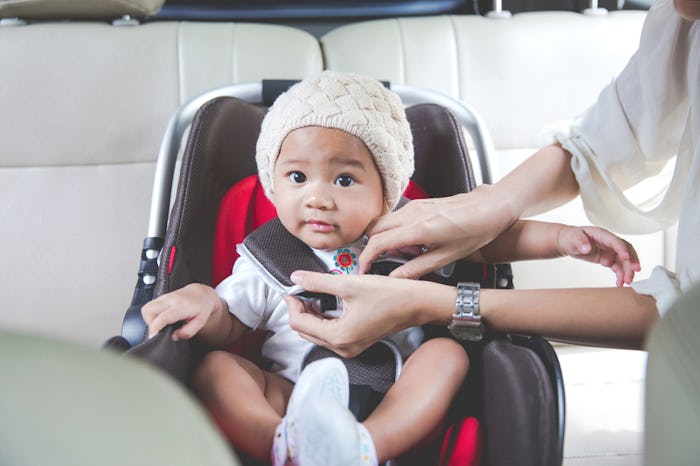Every year, parents are bound to read at least a headline or two about a celebrity shamed over their car seat usage or, far more tragically, about the fatal consequences of not using booster seats correctly. Seeing their child hurt in a car accident is every parent's worst nightmare, so it's important to understand car seat guidelines, broken down by age and weight, in order to keep kids protected. Guidelines and laws vary from state to state, so you'll want to make sure you're following local regulations, but here are some general rules to keep in mind.
According to the National Highway Traffic Safety Administration, there are four different kinds of car seats for children, and you'll want to make sure you're using exactly the right kind for their current age and weight. Keep in mind that some car seats are convertible or combination seats, which can be transformed from rear-facing seats to forward-facing seats or booster seats as children grow. If you're looking to purchase only one seat, that might be your best option — but you'll want to make sure you convert it to the appropriate style as your child grows up.
You'll want to go by manufacturer's guidelines for your baby's car seat, but here are some general age and weight markers you should follow:
Under 3 Years Old & Under 35-45 Pounds: Rear-Facing Car Seat
According to the American Academy of Pediatrics, you'll want to keep children in rear-facing car seats until they're at least 2 years old or exceed the highest weight or height outlined by the seat manufacturer.
Most AAP-recommended rear-facing car seats can be used up until a child hits 35 pounds. According to Parenting, some convertible car seats will let a toddler remain rear-facing until he or she hits 45 pounds, which isn't a bad idea, since most experts recommend that children remain rear-facing for as long as possible.
From 3 To 7 Years Old & Between 35-65 Pounds: Forward-Facing Car Seat
Moving on up in the world! Once your child has outgrown his or her rear-facing back seat and is at least 2 years old, it's time for a forward-facing seat. According to the National Highway Traffic Safety Administration, you'll want to keep your child in a forward-facing car seat with a harness and a tether until they're around 7 years old or have outgrown manufacturer's regulations.
According to the AAP's list of recommended car seats, most manufacturer's upper weight limit for forward-facing car seats sits at about 65 pounds, although a few are as low as 40 pounds and others go up to 85. (This is why you want to make sure you're checking your own car seat's guidelines carefully.)
From 8 To 12 & Under 100 Pounds: Booster Seat
When you're child's ready to graduate from his or her forward-facing car seat, it's time for a booster seat to make sure their seatbelt is sitting right. You'll want to make sure the seatbelt is lying across your child's upper thighs (not their stomach) and across their chest and shoulder (not their neck or face).
Most AAP-recommended booster seats have an upper limit of around 100 to 120 pounds, although some dip as low as 80.
Over 12 & Over 100 Pounds: Seat Belt
Congratulations! Your kid is all grown up and ready to buckle up. Remember, though, that kids under 13 still need to ride in the backseat for safety, per the National Highway Traffic Safety Administration's recommendations.
It may seem like a lot, but these guidelines save lives. One in three children who died in car accidents in the United States in 2011 weren't buckled up, according to USA Today. Using car seats and seat belts properly — every single time your children get in the car — helps keep kids safe, no matter where or how far you're driving.
Watch Romper's new video series, Romper's Doula Diaries:
Check out the entire Romper's Doula Diaries series and other videos on Facebook and the Bustle app across Apple TV, Roku, and Amazon Fire TV.
